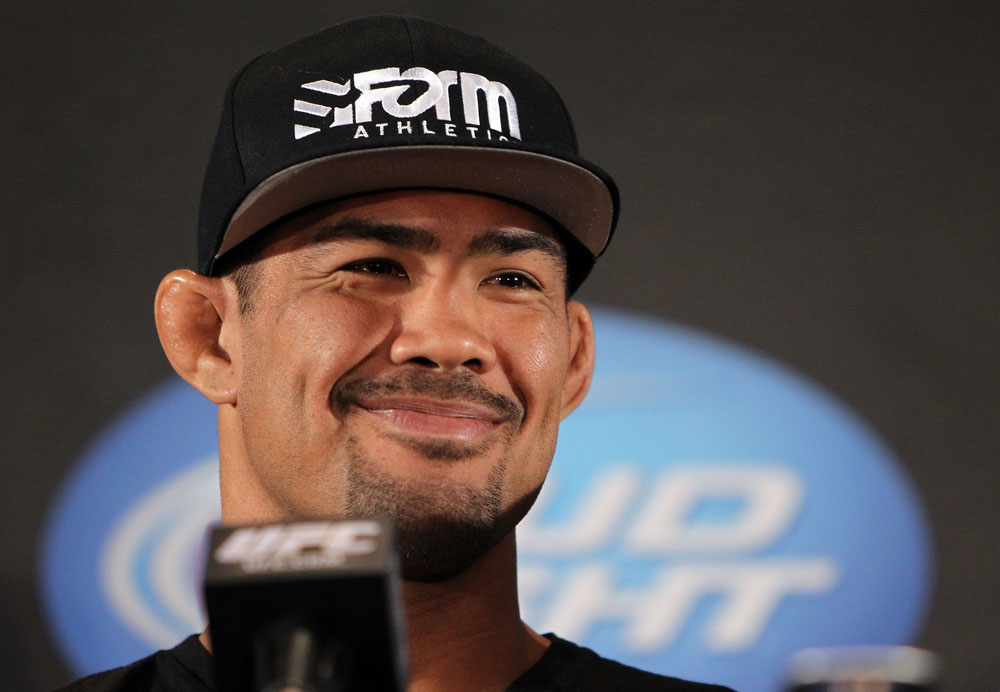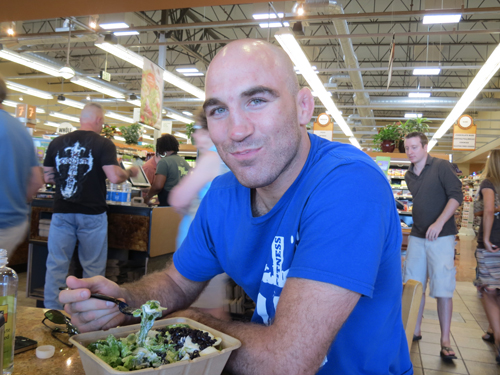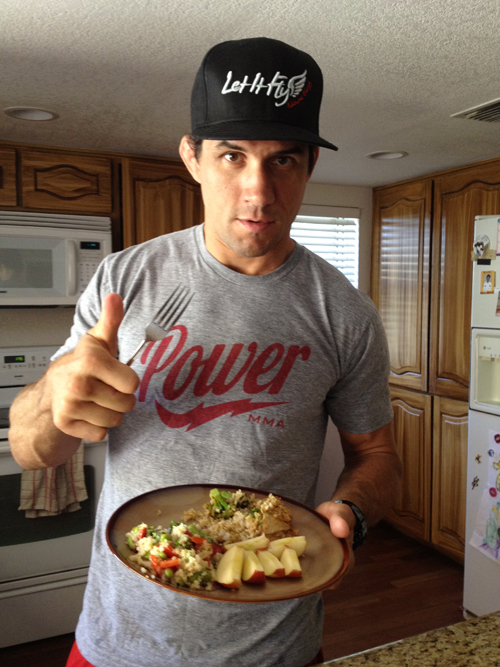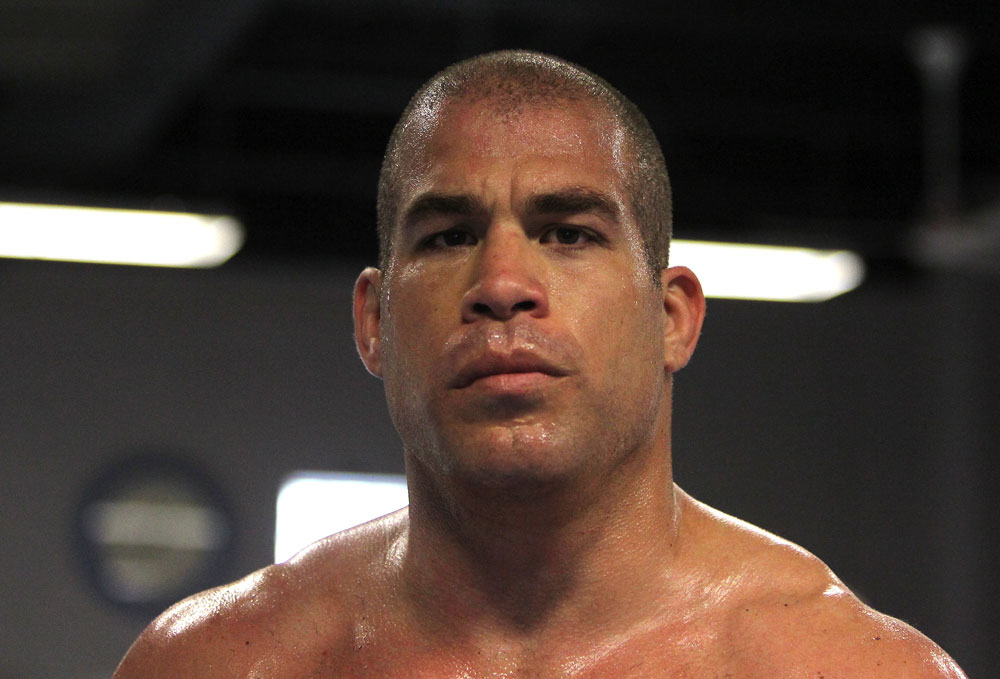 If the UFC ever hosts an eating contest, Mark Munoz could well emerge as a frontrunner. No joke. Especially if sushi or Filipino cuisine is on the menu. Born and raised by Filipino parents who both excel at cooking, it’s no wonder that Munoz himself can throw down inside of the kitchen and make a mean Chicken Adobo, along with a wide array of other dishes. Though he fights at 185 pounds, Munoz said he can pack away massive amounts of food in a single session and could easily walk around at 230 pounds if he wasn’t training for a fight. But much of the Oklahoma State University graduate’s preferred grub will have to wait until after his July 11 main event (UFC on FUEL TV 4) against unbeaten Chris Weidman (8-0). In a recent interview, Munoz breaks down some of his favorite Filipino dishes and the diet that helps the former 205er make the tight cut to middleweight.
If the UFC ever hosts an eating contest, Mark Munoz could well emerge as a frontrunner. No joke. Especially if sushi or Filipino cuisine is on the menu. Born and raised by Filipino parents who both excel at cooking, it’s no wonder that Munoz himself can throw down inside of the kitchen and make a mean Chicken Adobo, along with a wide array of other dishes. Though he fights at 185 pounds, Munoz said he can pack away massive amounts of food in a single session and could easily walk around at 230 pounds if he wasn’t training for a fight. But much of the Oklahoma State University graduate’s preferred grub will have to wait until after his July 11 main event (UFC on FUEL TV 4) against unbeaten Chris Weidman (8-0). In a recent interview, Munoz breaks down some of his favorite Filipino dishes and the diet that helps the former 205er make the tight cut to middleweight.
Curreri: You were born in Japan and both of your parents were from the Philippines.
Munoz: I was in Japan for two years and then moved to Vallejo, California and I’ve been eating Filipino food my entire life.
Curreri: What are some of the staples of Filipino food?
Munoz: Our main staple is white rice; that’s what we have for breakfast, lunch and dinner. Then we have curries, stew, stir fried noodles, fried food and barbequed. You name it, man, we got it. It’s so good and so rich. I love it, man, but during fight camp I can only eat the stews because they’re healthy. All of the other food I eat after my fights.
Curreri: Growing up, were both of your parents good cooks?
Munoz: Both parents. My mom predominantly cooked inside of the house. My dad would cook us breakfast and prepare our lunches. My mom is the chef in the house. She would make unbelievable meals.
Curreri: Given that pedigree, are you a capable cook?
Munoz: Yes, I love cooking and I can cook a lot of stuff. I cook nilagang, chicken adobo, pork adobo, lumpia, which is kind of fried egg rolls. I cook rice all the time; we have a rice cooker at the house. I also cook a breakfast sausage.
My parents owned a restaurant and I cooked for the restaurant in Pittsburgh, California; it was named “Rudy’s” after my dad’s first name. I worked there mostly on weekends and during the summers. We owned it for a good six years, so part of my life I spent at the restaurant cooking breakfast foods and helping prepare Filipino food.
Curreri: The native tongue for Philippines is Tagalog. Do you speak it?
Munoz: Yes, I do now. My parents always spoke to me in Tagalog growing up so I always understood the language, but they always wanted me to respond back in English so that I wouldn’t be confused in school. Now when I go to the Philippines I respond back in English and they go, ‘You don’t speak Tagalog?’ I’d say I don’t speak it but I understand it. But I’ve been practicing it and I can speak it now. But three years ago I had a hard time.
Curreri: I would be remiss if I interviewed you and did not ask you, a die-hard Manny Pacquaio fan, about your thoughts on that crazy, unjust decision a few weeks ago against Timothy Bradley.
Munoz: I did watch it and I was tweeting the results round by round. I scored that fight 117 to 111 (for Pacquiao). I couldn’t believe it. That was just robbery, thievery.
Curreri: Diet is obviously instrumental for an elite fighter, especially one who was previously a 205er and now fights at 185.
Munoz: I’ve been dieting ever since cutting down to 185 in April 2009. I decided to make a healthy change and my diet has been great ever since. I still eat Filipino foods but only in moderation. That’s the key.
Curreri: Is your wife of Filipino descent as well?
Munoz: She’s German, Irish and Polish.
Curreri: So if you want to eat the good stuff you have to cook it yourself, huh?
Munoz: Yeah, or my mom will come over and cook the good stuff. Or my aunts and uncles. My uncle came over the other day and brought me some Filipino food.
Curreri: I was a humongous eater in my younger days and, I don’t know why, but I almost have the sixth sense for detecting other humongous eaters and you strike me as someone who fits the bill, someone who can really put away astonishing amounts of food.
Munoz: (laughs). Yeah, you’re right dude, I can put it down! People say that about me all the time. We go to all-you-can-eat Sushi restaurants and people are like, ‘Dang, Munoz! I’d kick you out if I was the owner of this place!’ I mean, I eat like three party trays of the stuff.
Curreri: So the restaurant loses when they invite you to all-you-can-eat?
Munoz: That’s right. They invite me to all-you-can-eat – I will eat me plus five!
Curreri: Now, we hear so much about how brown rice, quinoa and whole grains are the ideal carbs for us, especially athletes. But white rice is so embedded in Filipino cuisine. What is your position on that?
Munoz: I eat white rice periodically, not all of the time now. I grew up on it and after researching different articles and journals I feel that brown rice and quinoa and brown rice noodles are more digestible and readily absorbed in the body than white rice. White rice is actually stored as glycogen or fat, whereas brown rice and the other grains enter the bloodstream and are used quickly. So I usually eat brown rice, brown noodles and quinoa.
But when I eat Filipino food, I go all the way, man! I eat white rice. But again, moderation is the key. You can’t eat that every night.
Curreri: It does seem that white rice accentuates the taste of the rest of the meal better …
Munoz: Yeah, you’re right. So I can’t have Filipino any other way. I can’t have brown rice with my adobo or other dishes. I can’t have that.
Curreri: So take us through a typical day of eating for you, starting with your earliest meal.
Munoz: For my earliest meal of the day I’ll have two whole eggs and four egg whites. Then a bowl of oatmeal with chia seeds and flaxseed. I’ll also have Vitamin C, a multi-vitamin and some branch chain amino acids.
Then after my first workout I’ll have a recovery protein shake with whey protein isolate, glutamine, branch chain amino acids and some electrolytes.
After that I’ll have a six-ounce chicken breast with quinoa, spinach or asparagus, some different colored peppers, broccoli or green beans.
Another meal will be similar to that.
I’ll have another protein shake after my later workout and another meal with carbohydrates at the end of the night.
Curreri: So 185 is a hard cut for you?
Munoz: I have to be very strategic for my cut to 185.
Curreri: How heavy would you be if you didn’t have a fight coming up, if you were just training
Munoz: I’d be 225, 230.
Curreri: You consume BCAA’s not only after your workouts, but before them. Why?
Munoz: Branch chain aminos are the building blocks of protein. I’m getting ready to workout with my meal and my muscles are going to need those BCAA’s. So I go before and after. I also take them at night for recovery.
Curreri: You mentioned the Filipino stews that you consume even during training camp. What makes them so healthy?
Munoz: So … Manny Pacquaio eats this stew called … tinola … It has cabbage in it, chicken, leaves, spinach, potatoes, sweet potatoes, onions, garlic … so a lot of anti-oxidants are in the stew. You boil the vegetables and then you drink the sauce. It’s a very good meal for you.
Curreri: How frequently are you able to eat those stews?
Munoz: I probably eat it once or twice a week.
Curreri: After you make weight what meals do you try to rehydrate with?
Munoz: After my fight I like to take in coconut water. I’m an island guy so coconuts go well with my diet. I wish I could have seen (the coconut water) craze because it’s going crazy. I’ll drink a lot of water as well and as many electrolytes as I can because making weight kind of dehydrates your body. Then I’ll eat the same things I’ve been eating for the past six to eight weeks. I don’t want to switch up my diet until after my fight. I will enjoy the occasional pizza or In & Out burger or Filipino food, and a lot of sushi. I eat that stuff after my fights. But I’ve been doing all the same things for this fight. I feel I have all the tools and resources to win this fight (against Chris Weidman).


 Imagine this: It’s 2 a.m. and Joe Silva is wide awake reading a book in the basement of his home. Suddenly an epiphany strikes, causing the
Imagine this: It’s 2 a.m. and Joe Silva is wide awake reading a book in the basement of his home. Suddenly an epiphany strikes, causing the 